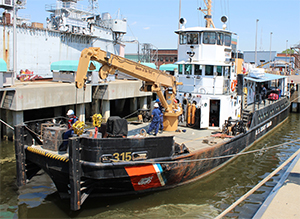Replacement of the U.S. Coast Guard’s aged fleet of 35 inland construction and aids-to-navigation tenders has finally begun.
After years of deferring recapitalization of the inland tender fleet in favor of more urgent needs, the Coast Guard’s fiscal 2018 budget includes $1.1 million to formally begin selecting a design for a new standardized vessel that will replace the aging and varied tenders now serving the nation’s inland waterways.
Coast Guard Commandant Adm. Paul Zukunft spoke to the House Appropriations Homeland Security Subcommittee in May about the urgent need to recapitalize the “long overlooked” inland fleet, and described how the Coast Guard would like to proceed with that process.
“We’ve already reached out to the Army Corps of Engineers and are looking for a commercial off-the-shelf design for an inland tender that could be modified depending on where it’s going to be operating, but would have the same engines, basically the same design, and could be built for roughly about $25 million a copy in a commercial shipyard here in the United States,” he said.
The selection of one design to replace the entire fleet of inland vessels for both the Coast Guard and Corps of Engineers will mean significant savings on maintenance costs, parts acquisition and training throughout the service life of the new vessels. If their service lives match those of a few of the existing tenders, they could still be in service in 2090.
USCGC Smilax, commissioned in late 1944, has been in continuous service for 73 years, just six months longer than USCGC Bluebell, also part of the inland fleet. Smilax holds the distinction of being “Queen of the Fleet” as the oldest commissioned cutter in the Coast Guard.
Only two vessels older than Smilax remain in the United States military. USS Constitution, launched in 1797, is the oldest U.S. Navy ship in commission as well as the oldest commissioned warship afloat in the world. USCGC Eagle was built in 1936 for the German navy and commissioned into U.S. service two years before Smilax. Eagle recently completed the third year of a four-year major service life extension project.
The advanced age of the inland tender fleet is not limited to the veterans of World War II. The 35 inland construction and aids-to-navigation tenders form one of the oldest collections of ships in U.S. service, with an average age of 52 years.
One of the newest vessels, USCGC Hudson, is described on its webpage as “the second in a series of four of the Coast Guard’s most modern inland construction tenders.” Hudson was commissioned in 1976.
“The time to replace them has arrived,” Zukunft said, summarizing the age of the fleet.
The Coast Guard has not released detailed specifications or requirements for the new vessels.

